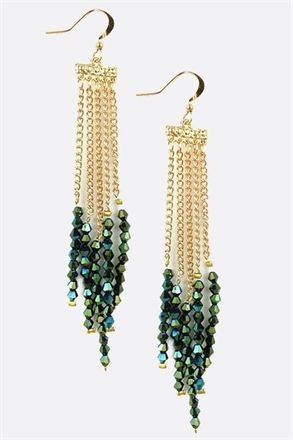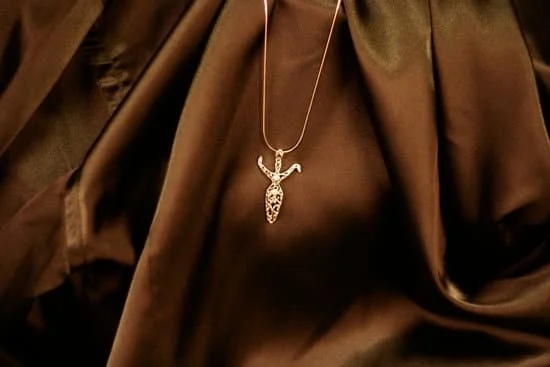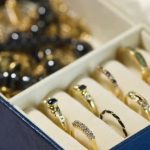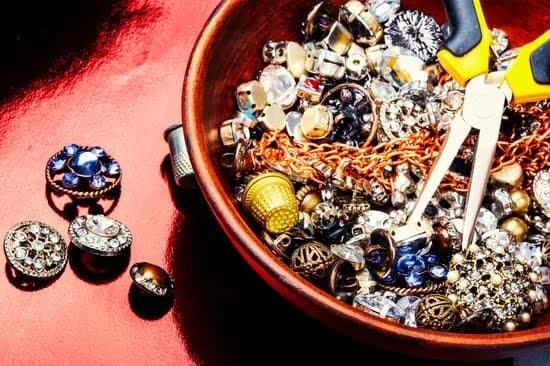1920s art deco jewelry is the iconic design aesthetic that was popular during the 1920s to 1930s. It is characterized by a blend of geometric and angular shapes, bold colors and ornate embellishments. Art Deco jewelry is named after the 1925 French International Exhibition Arts Decoratifs, which showcased a unique combination of European and indigenous design elements.
Art Deco jewelry often reflects its modernist ethos by combining old-fashioned motifs with elements of futuristic style. From diamonds to jewels of all types (such as topaz, sapphires, emeralds, tourmaline and aquamarine), the possibilities are only limited by one’s imagination.
Origins: Influences Behind 1920s Art Deco Jewelry
The popularity of 1920s art deco jewelry was greatly influenced by the cultural changes happening in Europe at that time. The growing taste for modernist products resulted from advances in manufacturing processes as well as new materials like bakelite and chrome-plated metals becoming available for use in creating jewelry pieces.
In addition to being aesthetically pleasing, these designs were also highly practical and long lasting – perfect for everyday wear or special occasions alike. In addition to these progressions in material production, artists from many different cultures were also inspired to create their own interpretations of the style resulting in pieces that featured a great variety of decorative motifs such as Egyptian snakes or Assyrian lions among others.
Overview: Popular Design Elements & Wearability
Typical features used throughout 1920’s art deco jewelry include strong line work, bold stones (sometimes cut into forms like stars), blocky geometric shapes and intricate details on various surfaces including metalwork and enameled designs/paintings on gemstones/baubles etc. Another aspect which made this type of adornment desirable was its wearability; pieces could be worn casually yet still dress up an outfit perfectly when needed – – they often did double duty due to their timelessness making them worth investing in.
Furthermore, given their strong visual presence not seen back in other eras – – there is something unmistakably beautiful about these classic designs which continues to make them so sought after even today.
Materials Used in Vintage Art Deco Jewelry & Their Properties
The 1920s saw a massive wave of cultural and societal revolution that is encapsulated by the term “roaring twenties”. This wave of change was also accompanied by an increase in creativity and experimentation when it came to fashion, including jewelry.
This resulted in a wide variety of beautiful pieces being crafted during this era, many of which incorporated Art Deco elements into their design. One of the most recognizable characteristics of Art Deco jewelry is the use of striking gemstones, precious metals and other materials in its designs.
Gemstones were prominently featured in vintage Art Deco jewelry pieces, with diamonds usually taking centerstage. These were often cut into unusual shapes such as square or triangle cuts that gave the charms special effects when captured by light.
Sapphires, turquoise and coral were also popular choices for these pieces – these bold colors made them eye-catching even from a distance. The vibrant colors of each gemstone did not just look beautiful either – many people believed that they could bring luck or protection to the wearer if placed correctly on a piece.
Metals were used just as frequently in Art Deco jewelry as gemstones, often paired together for beautiful contrast between warm shades and cool blues. Gold was the most common choice since it blended perfectly with delicate cuts and intricate diagrams typical to Art Deco accessories but silver was used just as regularly too. Platinum was mostly used to set off gemstones due to its white hues – its strength makes it both durable and elegant at the same time.
Finally, other elements like snake-like motifs or geometric patterns provided further swirls of movement to vintage Art Deco jewelry pieces that enhanced their charm gravity even further. While some were hand painted onto surfaces with brushstrokes via enameling technique, others were carved directly onto raw materials through engraving technique, creating incredible three-dimensional designs with textures all around them.
Identifying Pieces of Authentic Art Deco Jewelry
The 1920s was an explosive and vibrant period in history full of new inventions, movements and lifestyles. It was reflected even in the jewelry of the times with art deco pieces that were unique and dynamic. From geometric shapes to highly recognizable motifs such as bold stepped lines, racetrack circles and sunbursts, there are a number of factors to look for when identifying authentic art deco jewelry.
One of the primary telltale signs that a piece is from this era is the style of clasp used, which often saw pin closures combined with safety catches. These clasps feature a simple C shape that allows the wearer to secure it with ease. It was also typical for stones to be set into pedestals crafted as ogees or French scroll designs, giving an elegant lift to any piece of jewelry.
In terms of stone cuts, larger versions could vary depending on the feel designers wanted to evoke from their pieces. The most common shine resources chosen tended to fall within two distinct styles; one featured pyramid-shaped edges or truncated corners known as step cut diamonds, while brilliant cut gems offer maximum sparkle for breathtaking effect. A combination between these two options serves up something unique yet still luxurious enough for the trendsetters of the twenties.
To identify whether a piece of art deco jewelry is truly original or only decorative replicas inspired by this vintage style can be tricky; but using attention to detail and knowledge about certain elements should give you an indication into its authenticity. Check closely for metal type along with clasp design, stone settings and cut – all sure signs that will guide you on your journey through time.
Popular Design Elements of Vintage Art Deco Jewelry
The Art Deco style of jewelry emerged in the 1920s as a reaction to traditional Edwardian and Art Nouveau designs. These new bolder pieces sought to characterize modernity and break free from the frills of their predecessors. The Art Deco period made use of several design elements which have become staples of vintage and antique jewelry, namely filigree, engravings, and bezels.
Filigree was used during the Art Deco era to create intricate patterns and highlights that had a lot of dimension in minimal space. Oftentimes these earrings or necklaces featured a bright center stone with threadlike accents all around it. This whimsical style is often associated with colorful yellow gold settings cast off by intricate rose gold spirals for added contrast.
Engraving was also popular throughout Art Deco jewelry. Intricate lines, symbols, and repetitive patterns would adorn bracelets, rings, fur clips and other items from this era.
Scrolls, geometric shapes such as diamonds, triangles or sunbursts, waves and wheat sheaf motifs are among some that vintage jewelers liked to incorporate into their work. As time moves on these designs have become more iconic through a combination of careful craftsmanship and effective marketing strategies by the largest jewelers of the time period like Cartier and Tiffany & Co.
Bezels are another frequently seen feature in Art Deco jewelry, consisting generally of raised edge rims or frames with tightly set stones along its surface. While many bezel rings appear as solid planes due to their small size or lack of ornamentation; others were noted for having multiple textures within one piece utilizing either plain metal strands or engraved decorations in between different-shaped frames surrounding the stones’ edges.
Doing this allowed for brighter diamonds to catch the eye without taking away from any side-stones when needed due to its contours geometric emphasis on shape iteration rather than ornamentation detail along its ridges. Ultimately this simple yet complex technique proved very prominent in engagement rings being commonly used into our times today even containing lacy under galleries if desired creating a continuous line thus making them ever more timeless creations as lives go by.
Styles & Periods of Art Deco Jewelry
The Art Deco jewelry movements of the 1920s were revolutionary in the world of fashion and remains one of the most sought-after and iconic design styles. Defined by its geometrical patterns and shapes, talented artisans blended materials including ivory, precious metals, enamel, pearls, and semi-precious stones to create unique and beautiful pieces. One of the main distinguishing characteristics of Art Deco jewels was their use of bold colors that were often brighter than those of previous eras.
Colors like royal blue, turquoise, yellow, pink, green, brown and black were used to great effect in combination with a variety of lines ranging from abstract to Op Art. These combinations resulted in minimalist aesthetic designs inherent in Art Deco style.
Another element found across the range of 1920s Art Deco jewelry was the incorporation of industrial materials such as chrome or nickel which lent a new aesthetic to high end fashion jewelry making it available to a larger demographic than ever before. Chrome beads, for instance which had been unheard off until this era quickly became popular among young women looking for something eye-catching yet affordable at the same time.
This advancement provided the ideal material for bold statement necklaces studded with rhinestones or encrusted with colored gemstones including red ruby glass beads which added an affordable sparkle to any outfit.
Many additional features distinguished Art Deco jewelry from other design eras like Edwardian, Victorian and Art Nouveau periods. Bracelets from this time period featured classical figures or Egyptian motifs executed in semi-precious stones that made them look incredibly expensive but still within reach for many shoppers.
Pendants hung from delicate chains adorned with polished cabochons cutout lockets all became very fashionable accessories during this era leading all way up through 1940s Hollywood glamour period when pursuing sophisticated elegance was on everyone’s minds.
Caring for & Storing Art Deco Jewelry
The roaring 1920s was a time of brilliant fashion and expression through jewelry. Art Deco jewelry made its mark as bold, opulent, and geometric.
Women adorned themselves with multi-colored gems set in precious metals like white and yellow gold. While many of these original pieces are no longer available to buy or are stored away in museums, there are still new replicas being produced today which capture the essence of the iconic style made famous by Coco Chanel and Jean Patou.
Storing Art Deco jewelry requires a special method to ensure longevity and avoid any damage from natural elements like humidity or dryness. It is recommended that all pieces be stored individually in museum-grade storage bags–made of either unbleached cotton or nylon–and placed in airtight boxes that protect the pieces from moisture and dust buildup.
Alternatively, suede pouches can be used for smaller items such as necklaces or bracelets but it is important to choose one that won’t scratch the metal or gemstones.
Finally, caring for Art Deco jewelry requires extra attention due to their detailed nature and fragile materials used to create them. Unlike modern costume jewelry, many original pieces have been handmade using delicate stones set with intricate patterns.
Cleaning should be done by gently wiping each piece with a soft cloth dampened with warm soapy water at least once a year is recommended to keep your priceless art deco pieces looking as good as new. If you’re not comfortable doing this yourself, then you should take it to an expert jeweler for professional cleaning as harsh chemicals could damage certain materials used to construct such treasured items.
History & Impact of Art Deco Jewelry on the Fashion World
Art deco jewelry is an iconic style of jewelry that first appeared in the late 1920s. It was characterized by geometric shapes, linear designs, and the use of industrial materials like metals and plastic.
Its popularity spread throughout the world, impacting cultures across many different countries, including Europe, North America, Australia, and China. Art Deco jewelry is often associated with the glamor and opulence of the age in which it was created; it often features luxurious materials such as diamonds, pearls, and rare gems set against brightly colored enamel or lacquer backgrounds.
The influence of art deco jewelry on fashion extended far beyond just the 1920s. Popularity for art deco designs continued long into the 1930s, 40s and 50s as people sought to add a bit of luxury to their everyday wardrobes – diamond bracelets were particularly popular during this period. Additionally, new technologies enabled manufacturers to produce complex designs from multiple angles, creating striking effects that would further fuel demand for art deco pieces over these decades.
As fashion trends evolved over time, so too did art deco jewelry – taking on different influences from various cultures around the world while still maintaining its distinct identity. This international appeal meant pieces could be found in countries as diverse as France, India, China and Japan – each country adapting the original aesthetic to suit their own unique sensibilities.
For example, Chinese art deco typically featured bright enamel colors and elegant flourishes while French pieces often favored intricate gold detailing and emphasis on line work.
Over time it has become clear that art deco jewelry has had an unprecedented impact on fashion – its ongoing popularity speaks volumes about its lasting impression even after close to a century since its inception. Now found in vintage marketplaces around the world as well as modern day boutiques alike; there’s no denying this era has left an indelible mark on both couture and costume jewellery alike – proving that good design never goes out of style.
Art Deco Jewelry Today
1920s Art Deco jewelry is a beloved trend among modern jewelry buyers and collectors. Art Deco jewelry pieces during the 1920s were made of brilliant stones, including diamonds, sapphires, emeralds and rubies. They featured angular geometric shapes set in platinum or white gold as common metal/stone combinations. Necklaces often had panels of stones while bracelets and earrings could be found with geometric designs.
Due to their timelessness, original pieces from the early twentieth century are still being sought after today and vintage jewelry dealers offer both complete sets as well as individual pieces for sale. Not only can these 1920s vintage treasures be purchased, but they also have modern interpretations and options available today.
One common way in which modern retailers honor Art Deco looks is through tribute collections that are inspired by the style of this period with flared edges and sharp lines along with contrasting colors. These made-to-order collections can often use the same materials such as diamonds and platinum that were used in original 1920s creations.
Another appreciation of retro styles includes iconic motifs like repeating circles, linear strips or geometric blocks which all emphasize the modern look while still honouring its inspiration from another era in time. Through such creative approaches we see how Art Deco styles continue to be re-imagined as people search for classic pieces that will never go out of fashion.
Unique & Interesting Facts About Art Deco Jewelry
The roaring 1920s was a time of dramatic changes in the world – notably, when it came to fashion and design. This decade saw an upsurge of popularity for some rather unique trends and styles, including Art Deco jewelry. Art Deco pieces were characterized by bold motifs like geometric shapes, minimalistic designs, and bright colors. Highly popularized during this era, Art Deco jewelry has been featured in modern pop culture ranging from music videos to television dramas.
Many popular figures have worn Art Deco-style jewelry throughout recent years. From Beyonce’s metallic necklace with intricate filigree detailing in her music video “Countdown,” to actress Ashley Benson donning a ruby-encrusted white gold bracelet while playing Hanna Marin on ABC Family’s hit series Pretty Little Liars, celebrities favor chic Art Deco-inspired pieces of baubles to add flair to their wardrobe.
Notably, Prada harkened back to the glitzy decade with its 2014 Fall/Winter product presentation featuring countless impossibly cool models sporting bee pendants around their necks and geometric earrings that alluded to the 20s style.
One of the most well-known designers of Art Deco jewelry is Raymond Templier (1879 – 1968). He was a renowned French goldsmith whose rare jewels featured motifs reminiscent of ancient Egypt and Mayan cultures such as scarab beetles, sun gods, pyramids, stars and a variety of highly stylized mythical creatures that became his signature look.
Templier’s designs used breathtaking combinations sof diamonds, sapphires, rubies and emeralds set glass enameling which made his work truly unique compared to other jewelers of this epochal period. His standout designs can be seen in many museum exhibits across Europe including displays at the Louvre Museum in Paris and Le Musée des Arts Décoratifs in Nice.
In summary, Art Deco jewelry experienced peak popularity during the roaring ’20s due its striking aesthetic combining bold geometic shapes with minimalist designs often outlined with colorful gems or stones set off with metalwork enameling making them timelessly sought after pieces even today both culturally significant so keep your eyes peeled for a sparkly piece of history from this fantastic era.

Welcome to my jewelry blog! My name is Sarah and I am the owner of this blog.
I love making jewelry and sharing my creations with others.
So whether you’re someone who loves wearing jewelry yourself or simply enjoys learning about it, be sure to check out my blog for insightful posts on everything related to this exciting topic!





